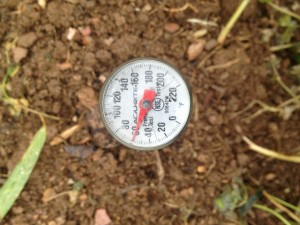Spring Food Plots: Conditions for Success
Filed under: Food Plots, Hunting Blog
This time of year I receive lots of questions about planting warm season food plots. Recently it has been raining or snowing throughout much of the whitetail’s range. It’s literally too cold or wet to plant in many regions.
Most crops that are planted this time of year have a relatively large and soft seed, such as Eagle Seed forage soybeans, corn, sunflowers, etc. These large and soft seeds readily absorb water as part of their germination process. In addition to needing water to break dormancy, they also require a minimal temperature to begin the germination process and a higher temperature to stimulate rapid germination and development.
Cold water without an increase in soil temperature will often result in the seeds simply swelling but not germinating. The longer a seed, especially a relatively soft seed, remains in the soil without germinating there are more chances for insects, diseases, or funguses to attack.
The result of delayed germination of soft seeds is almost always a reduced seed and/or plant vigor. It’s common for 50% or more of large soft seeds that are planted during bad conditions (especially when it’s too cold and wet) to die in the ground before they germinate. The surviving seeds can have reduced vitality even as a maturing plant (like a fawn that received poor nutrition during development or the first few months of life).
Even though it is time to plant based on tradition, the real indicator of when it’s time to plant is based on local conditions. For example, soybeans have the best germination rate when there’s adequate but not too much soil moisture and the soil temperature is a minimum of 60 degrees.
The soil temperature at my place has just reached 60 degrees at 9 am. Soil scientists monitor the soil temperature at 9 am as this is usually the coldest time of day at 2” deep in the soil. The soil cools all night and begins to warm once the sun is at an angle that its radiant heat impacts the soil.
If you plan to plant food plots soon, don’t count on going by traditional or published planting dates. Give your crops the best chance of success and plant when the local conditions are appropriate. As we’ve all seen recently it’s vitally important to keep an eye on the extended weather forecast!
Growing Deer together,
Grant





